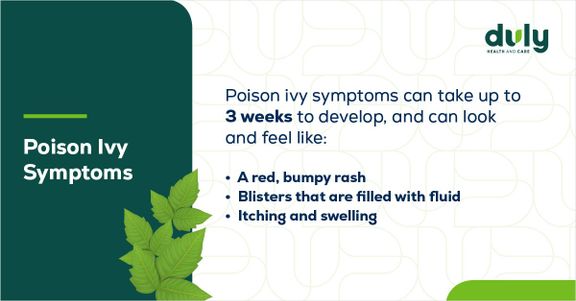Summer is a time for making memories. Whether you and your family are exploring the woods, walking on the bike path, or just hanging in the backyard, spending time outside is a great way to get some sun and spend some time together.
But no one wants those memories ruined with a case of poison ivy, oak, or sumac.

Poison ivy symptoms can take up to 3 weeks to develop, and can look and feel like:
- A red, bumpy rash
- Blisters that are filled with fluid
- Itching and swelling
A rash from a poisonous plant can turn a day of fun into a couple of weeks of itching and scratching. But when is a rash something you can treat at home — and when should you call a physician?
Here’s how you can keep your summer and your skin itch-free.
Step 1: Identify the Plant
Take some time to look at these common rash-causing plants if you don’t know what poison ivy, poison oak, or poison sumac look like. Looking at pictures of these poisonous plants can help you know how many leaves they have, what color they are, and where they may be growing. Knowing what plants to look out for is a step to take before you actually encounter these plants in the first place, and it can save the day and your skin.
Let’s say you’re camping, and your child walks a few yards away from your site and into the brush to pick a pretty flower… but you see they walked through some three-leafed plants to get to it. Uh-oh.
Step 2: Prevent the Rash if You Can
In this situation, you may actually be able to prevent a rash from spreading if you act fast. If you think you’ve come into contact with poison ivy, oak, or sumac, wash your hands with poison plant wash, dish soap, laundry detergent, or rubbing alcohol — whichever you have on hand. Wash gently and rinse with cool water (be sure to clean under your nails too).
Washing your hands in this way within 20 minutes might prevent a rash from forming and washing your hands within 60 minutes may reduce the rash’s intensity.
Step 3: If You Missed Identifying the Plant — Identify the Rash
It’s not always possible to realize you’ve touched a poisonous plant in the moment — so the next step is being able to identify what the rash looks like.
This can be especially confusing because it can take a while for the rash to show up in the first place. In fact, it can take as long as 3 weeks for a poison ivy, oak, or sumac rash to appear if you’ve never had one before. (But if it’s not your first, the rash tends to show up in as little as 4 to 48 hours.)
A rash from a poisonous plant typically looks like red, bumpy patches of skin — and of course, they come with an itch. Your rash might also look streaky or have little black bumps, too.
Sometimes, it might seem like your rash is spreading from one part of your body to another, but this isn’t the case. Likely what’s happening is the part of your body that had the most plant oil on it formed a rash first, and patches of skin with less plant oil formed later.
If you’ve never had poison ivy before, it can be tough to determine what’s causing your rash.
Schedule an appointment with your Duly Primary Care Physician or visit an Immediate Care location to have your poison plant rash diagnosed.
Find Immediate Care near you >
Step 4: Treat the Rash at Home
If you come into contact with poison ivy, oak, or sumac, you might be itchy and uncomfortable, but you can generally find relief and treatment at home.
Relieve Itching:
- Apply calamine lotion or hydrocortisone cream to your rash.
- Use a cool, wet washcloth as a compress on itchy areas of skin.
- Take an antihistamine allergy pill.
- Take a cool shower or a lukewarm bath.
Prevent Infection:
- Try not to scratch at your rash.
- Don’t pick open or pop blisters.
These rashes aren’t contagious, but if one person in your family develops a poison ivy rash, it’s likely someone else in the household will too. This isn’t because it’s being passed from person to person — it’s more likely that the poison ivy oil got on someone’s clothes and body, and then you washed their clothes, getting the oils on your skin as well.
Step 5: Know When to Call a Physician
Poison ivy, oak, or sumac symptoms typically clear up on their own within 2 weeks if you’ve already had this kind of rash before. If you haven’t, it can take 3 or more weeks to pass. But sometimes, seeing a medical provider is an important step in treating your poison ivy rash.
You should see your primary care physician or immediate care specialist if:
- You aren’t actually sure if your rash is caused by poison ivy, oak, or sumac.
- Your rash doesn’t get better (or seems to be getting worse) after 7 to 10 days.
- It seems like your rash might be infected.
Some people are much more allergic to poison ivy than others, and coming into contact with it can cause a more severe reaction. Call 911 or go to the emergency room if:
- Your rash covers a large part of your body — or if it forms around your genitals, eyes, or mouth.
- You are having trouble swallowing or breathing.
- You have a fever.
- Your face or eyes are swelling.
- Your rash becomes so itchy that you can’t sleep at night.
Summer can be a time of sun, smiles, and shorts — but it can also come with its own health and safety concerns. Taking some time to learn more about them can help you protect yourself and your family.
Whether you want to learn more about how the sun affects your body or how to make sure everyone stays safe at the pool this summer, your Duly providers are here to share the info and resources you need to have a happy and healthy summer.
Find Primary Care near you >
Health Topics:








